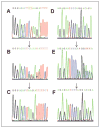High prevalence of BRCA1 and BRCA2 germline mutations with loss of heterozygosity in a series of resected pancreatic adenocarcinoma and other neoplastic lesions
- PMID: 23658460
- PMCID: PMC3959126
- DOI: 10.1158/1078-0432.CCR-12-3020
High prevalence of BRCA1 and BRCA2 germline mutations with loss of heterozygosity in a series of resected pancreatic adenocarcinoma and other neoplastic lesions
Abstract
Purpose: Pancreatic ductal adenocarcinoma (PDAC) is associated with the breast ovarian cancer syndrome (BRCA1/BRCA2) mutations. It is unknown if this association is causal.
Experimental design: This is a single-site study of patients who underwent surgical pancreatic tumor resection and self-identified as Ashkenazi Jewish. DNA from normal pancreatic tissue was genotyped for the three Ashkenazi Jewish BRCA1/2 founder mutations BRCA1 185delAG, BRCA1 5382insC, and BRCA2 6174delT, and loss of heterozygosity (LOH) was determined by sequencing DNA from microdissected tumor. When additional tumor tissue was available, p53 immunohistochemistry (IHC) was conducted.
Results: Thirty-seven patients underwent surgery for PDAC, seven for intraductal papillary mucinous neoplasm (IPMN), and 19 for other diseases. A high prevalence of BRCA1/2 mutations was found in the surgical cohort (12/63; 19.0%; P < 0.001), PDAC cohort (8/37; 21.6%; P < 0.001), and IPMN cohort (2/7; 28.6%; P = .01) compared with published control mutation frequency. A high prevalence of BRCA1 185delAG (8.1%; P < 0.001) and BRCA2 6174delT (10.8%; P < 0.001) in Ashkenazi Jewish patients with PDAC was shown. BRCA1/2 LOH was found in 2 of 4 BRCA1-associated PDACs and 3 of 4 BRCA2-associated PDACs. Positive p53 IHC was found in 5 of 8 BRCA1/2 PDACs.
Conclusions: We show a high prevalence of BRCA1/2 mutations with LOH in an Ashkenazi Jewish cohort of surgically resected PDAC and neoplastic lesions, suggesting that these germline mutations are causal in selected individuals.
©2013 AACR.
Conflict of interest statement
No potential conflicts of interest were disclosed.
Figures


Comment in
-
Delineating the effects BRCA1 and BRCA2 loss of heterozygosity in pancreatic cancer progression.Clin Genet. 2014 Jan;85(1):18-20. doi: 10.1111/cge.12306. Epub 2013 Nov 18. Clin Genet. 2014. PMID: 24147435 No abstract available.
References
-
- American Cancer Society. Cancer Facts & Figures 2012. Atlanta, GA: American Cancer Society; 2013.
-
- Klein AP, Hruban RH, Brune KA, Petersen GM, Goggins M. Familial pancreatic cancer. Cancer J. 2001;7:266–73. - PubMed
-
- Verna EC, Hwang C, Stevens PD, Rotterdam H, Stavropoulos SN, Sy CD, et al. Pancreatic cancer screening in a prospective cohort of high-risk patients: a comprehensive strategy of imaging and genetics. Clin Cancer Res. 2010;16:5028–37. - PubMed
-
- Canto MI, Goggins M, Hruban RH, Petersen GM, Giardiello FM, Yeo C, et al. Screening for early pancreatic neoplasia in high-risk individuals: a prospective controlled study. Clin Gastroenterol Hepatol. 2006;4:766–81. quiz 665. - PubMed
Publication types
MeSH terms
Grants and funding
LinkOut - more resources
Full Text Sources
Other Literature Sources
Medical
Research Materials
Miscellaneous

